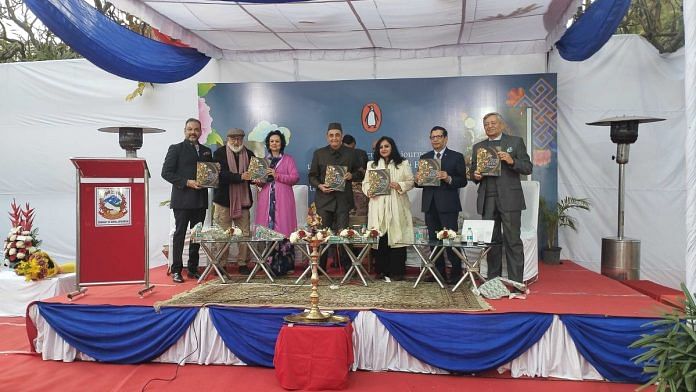New Delhi: The tables were laden with Nepali delicacies—platters of chiura ko pulao or stir-fried beaten rice, tureens of kukhura masu ko choila where spiced chicken cubes are barbecued, bowls of kheer, and piping hot, crisp-fried pancakes or malpuwas. But it was momos that dominated the discussion at the launch of Rohini Rana’s new collection of recipes, The Nepal Cookbook, on the grounds of the Embassy of Nepal on 20 January.
Food is not just the way to a person’s heart; it is also a roadmap of a country’s culture and history. Rana, who is married to former Nepal army chief, General Gaurav SJB Rana (retd), shares her discovery of her adopted home through its food.
Her starting point is momos—the versatile steamed or pan-fried dumplings, the fillings of which range from the traditional pork and bamboo shoots to tandoori chicken and paneer and even chocolate.
“Momos depict the unity in diversity,” said Rana.
These parcels of joy are as intrinsic to Nepali cuisine as they are to India’s street food culture. Her cookbook mentions 36 kinds of momos from Nepal, including momo chaat and giant dumplings with meat and pork.
“I think it is really going to help sell my book because momo is beloved to everyone’s heart,” says Rana.

Also read: Assam to Mizoram & 20-hour bumpy ride—how Kuki-Zomi students return to Manipur to get degrees
Seducing the Indian palate
Both Nepal and Tibet lay claim to discovering momos. One legend has it that it was a Nepali princess, Bhrikuti Devi, who introduced momos—and Buddhism—to Tibet in the 7th century when she married the Tibetan king Songtsen Gampo.
Another theory suggests that the Newar community of traders from Nepal was intrigued by a dish called ‘Mog Mog’ in Lhasa, China.
“They brought it back to Kathmandu. They started making Momocha by filling the small, steamed dumplings with Yakhni (meat), which is now known as momos,” says Rana.
Momos are popular among the Newars and Sherpa who have variations like shogo, shabril, and dhapu momos.
Food critic and historian Pushpesh Pant describes momos as the one dish that effortlessly competes with murg malai tikka from India in terms of popularity.
“It’s the one food which has not stopped evolving,” said Pant in a conversation with Rana at the book launch. Much like paneer dosa and palak dosa, dumplings like tandoori momos are a synthesis of diverse cultures and a testimony of entrepreneurship.
Nepalese entrepreneurs who set up momo stalls know what Indians want to eat.
“They’re not trying to please the Indian palate. They are seducing the Indian palate,” he added.
Snail curry to wild lichen
In her previous cookbook–The Rana Cookbook–Rana gave readers a peek into royal cuisine from Nepal’s palaces. Her latest collection of recipes revels in the diversity of the country’s cuisine.
“They eat beef, pork, and haans [ducks]. They live in peace,” says Pant.
Rana drew inspiration from Nepal’s founding father, King Prithvi Narayan Shah, who described the nation as a “garden of four castes and 36 ethnicities”. She uses this as the blueprint for her cookbook.
The Nepal Cookbook has a selection of recipes from the Sherpa and Thakali communities from the mountains; the Chhetri, Gurung, Tamang, Newar, and Kirati communities in the lower mountain ranges; and the Tharu and Madeshis in the Terai forests in the south. Shyakpa and Thupka recipes from the Sherpa section ease into Kanchemba (buckwheat fries) and Ghinti (dried blood sausage) from the Thakali community.
Rana sees Nepal’s cuisine as a reflection of its geographical diversity from the Himalayas to the plans (Terai). The people in Nepal live in an extremely drastic and challenging environment. They follow diverse social practices and religions, and all these factors influence their food culture and eating habits, she says.
“This cookbook is not merely a compilation of ingredients and instructions, it is a tribute to the talented chefs and the home cooks who have preserved and shared their cooking wisdom,” said Nepalese Ambassador to India, Shankar Prasad Sharma.
Sourcing some of the recipes—which she did during the Covid-19 pandemic—was not easy. “Some people didn’t want to share the recipes. I had to go to them and learn,” said Rana.
Pant describes the collection of 108 recipes as an encyclopedia and food map of Nepal, also offering a sociological concept of the nation with insight into the traditions and practices of ethnic tribes and communities.
A recipe for wild edible lichen called Yangben, which travelled to eastern Nepal from China’s Yunnan region, lists pork blood as one of the ingredients. On the other hand, aloo chokha—spiced potatoes with coriander and ginger— from the Madheshi community is a favourite in India as well.
“I came here especially to taste the aloo ko achar. It has strong spices. It’s something different,” said a young chief at the event.
(Edited by Ratan Priya)






